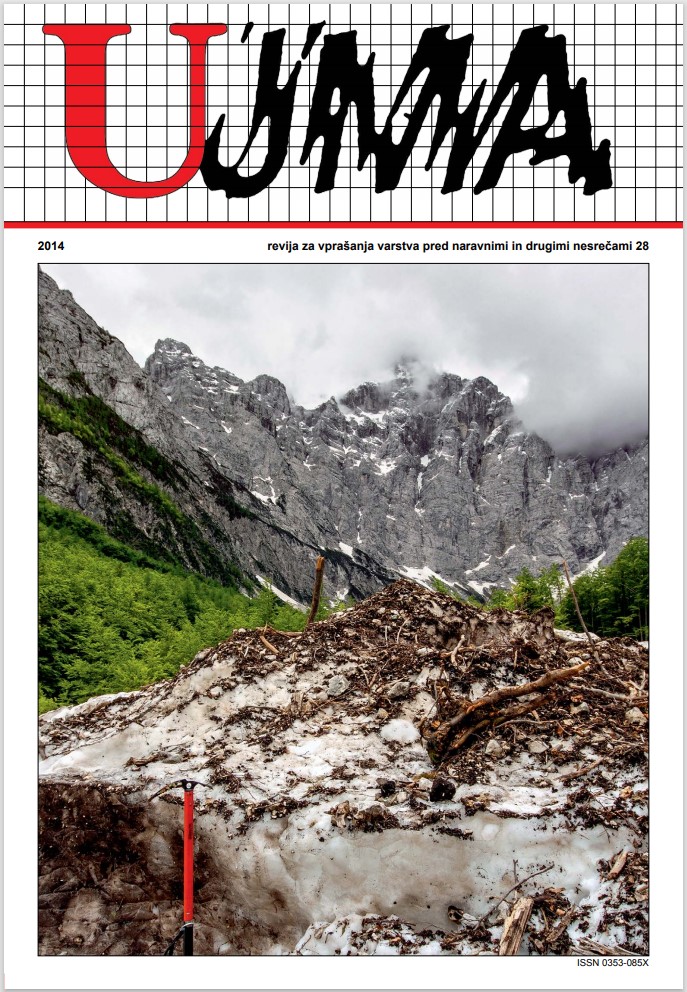INTRODUCTION OF NEW PREVENTIVE MEASURES FOR THE LIMITING OF WILDFIRES
Abstract
The yearly number of wildfires in the western Slovenia places this part of the country among high-risk fire areas, particularly affected by fires in late winter (February, March) and summer months (July, August). Statistics for the last ten years (http://spin.sos112.si, June 2014) show that the size of burnt areas has not declined. Increase in average annual temperatures and overgrowing of the most fire-prone areas in Slovenia contribute to the creation and spread of wildfires. Such forecasts call for additional preventive measures to effectively prevent fires and limit their consequences. One possible additional preventive measure is prescribed burning which, in certain circumstances and in selected areas, may reduce or eliminate combustible materials and thus prevent fires or limit their intensity. After the controlled application of fire, an area is rapidly overgrown with humid vegetation of poor combustibility. Prescribed burning is appropriate for critical points or areas where fires occur frequently, for example, along the railway lines or other identified strategic points.
References
A Guide for Prescribed Fire in Southern Forests. United States Department of Agriculture, Forest Service Southern Region. Technical Publication. 1989.
Ascoli, D., Bovio, G., 2013. La tecnica del fuoco prescritto. Aracne editrice S. r. l., Roma, Italia.
Batič, F., 2001. Vpliv požarov na vrstno sestavo vegetacije s Krasa in Istre v jugozahodni Sloveniji. Zbornik gozdarstva in lesarstva, št. 66, 25–38.
Forest fires: Couses and contributing factors in Europe. European Parlament, Economic and Scientific Policy, Brussels, 2008.
Gasilska zveza Slovenije, www.gasilec.net/operativa/gasilska-tehnika/cenik, julij 2014.
Gozdnogospodarski načrt Kraškega gozdnogospodarskega območja, 2012, št. 14/11. Zavod za gozdove Slovenije, Območna enota Sežana.
Jug, A., 2002. Požari v naravi – vpliv na razvoj in višine plamena v gozdnih požarih. Varstvo pri delu, varstvo pred požari in medicina dela. Mednarodni posvet. Portorož, 14.–15. 5. 2002.
Jurca, M., 2001. Vpliv požarov na entomofavno - predvsem subkortikalno, v monokulturah črnega bora (Pinus nigra Arn.) na slovenskem Krasu. Zbornik gozdarstva in lesarstva, št. 66, 39–64.
Kajfež-Bogataj, L. in sodelavci, 2004. Scenarij podnebnih sprememb kot temelj za oceno ogroženosti z vremensko pogojenimi naravnimi nesrečami v prihodnosti.
Klečar, S., Kratohvil, M., Marotti, R., Paluh, M., Szabo, N., Vinković, M., Vučetić, M., 2010. Osnove gašenja požara raslinja. Vjesnik d. d., Zagreb.
Košir, B., Jež, P., 2008. Sanacija sestojev po požaru na območju Komna. Gozdarski vestnik, letnik 66, št. 4, 212–225.
Montied, C., Kraus, D., 2010. Best practices of fire use – prescribed burning and suppression fire programmes in selected case-study regions in Europe. European forest institute, Finland.
Operativno taktični postopki, 2011. Razvojno raziskovalna naloga Gasilska zveze Gorenjska, 2011. Gasilska zveza Slovenije. http://www.gasilec.net/, julij 2014.
Poročila Zavoda za gozdove Slovenije o gozdovih od 2001 do 2011. Zavod za gozdove Slovenije, 2012. http://www.zgs.si/slo/zavod/informacije-javnega-znacaja/letna-porocila/, julij 2014.
Šturm, T., 2010. Požarna ogroženost in napovedovanje pojavljanja gozdnih požarov. 3. Seminar in delavnica iz varstva gozdov. Zavod za gozdove, Ljubljana.
Uprava RS za zaščito in reševanje, SPIN. http://spin. sos112.si/SPIN2/Javno/Porocila/, julij 2014.
Uradni list RS, 2014. Uredba o varstvu pred požarom v naravnem okolju. Uradni list RS št. 20/2014.
Vochl, S., De Groot, M., Japelj, A., 2013. Ogenj kot orodje; stanje in perspektiva v Sloveniji. Gozdarski vestnik, letni 71, št. 3, 141–152 in 169–170.
Zafošnik, A., 2004. Požarna preventivna. Gasilska zveza Slovenije, Ljubljana.
Zupan, M., 2010. Varstvo pred požarom – kompetence izvajalca usposabljanja. Ujma 24, 252–258.
Downloads
Published
Issue
Section
License

This work is licensed under a Creative Commons Attribution-NonCommercial-NoDerivatives 4.0 International License.
The articles are made available to the public under Creative Commons Attribution-NonCommercial-NoDerivatives 4.0 International (CC BY-NC-ND 4.0).


